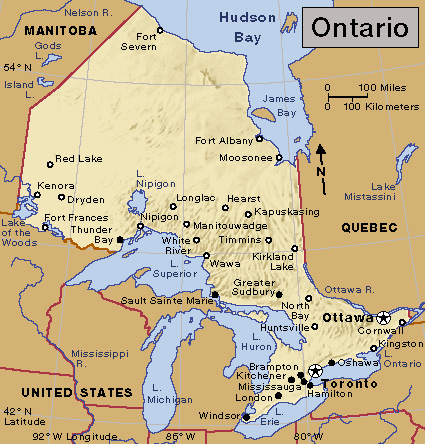Kitchener (pop. 256,885; met. area pop. 575,847) is a city in southern Ontario. It was the birthplace of W. L. Mackenzie King, who served three terms as prime minister of Canada. Kitchener lies 65 miles (105 kilometers) west of Toronto.

Kitchener lies next to the city of Waterloo and is the center of the regional municipality of Waterloo. Kitchener and Waterloo form a single community, but each has its own government. Kitchener has a mayor-council form of government. Many people in Kitchener have German ancestry.
The Kitchener Market attracts many tourists because of its famous German and Pennsylvania Dutch food and style of cooking. Other points of interest include Woodside, King’s boyhood home; and Doon Heritage Village, a reconstruction of a community as it may have appeared in the mid-1800’s. Every fall, thousands of visitors come to Kitchener and Waterloo for the Oktoberfest. This nine-day celebration is based on the famous beer festival of Munich, Germany.
Kitchener’s chief products include automobile and electronic parts, clothing, food and beverages, furniture, plastic products, and rubber. Kitchener serves as the trading center for a rich agricultural area in the Great Lakes Lowland region of Ontario. Waterloo is the home of St. Jerome’s University, the University of Waterloo, and Wilfrid Laurier University.
In 1805, Mennonites from Pennsylvania established the first permanent settlement in what is now the Kitchener-Waterloo area. They chose the location because of the fertile land and named their community Sand Hills. During the early 1800’s, many German immigrants settled there. About 1830, the settlement was renamed Berlin, after the capital of Germany. Berlin became the county seat of Waterloo County in 1876 and was incorporated as a city in 1912. In 1916, during World War I (1914-1918), the voters renamed the city Kitchener to show their support of Canada and Britain. Horatio H. Kitchener was a famous British soldier who had drowned at sea a short time before.
Many new industries opened in Kitchener after World War II ended in 1945. They created thousands of new jobs and helped the city’s population rise from 44,867 in 1951 to 74,485 in 1961. In the early 1970’s, Kitchener began to redevelop its downtown section. The old City Hall was torn down. A new tower for city offices opened in 1973. In the late 1970’s, Mackenzie King Square was completed near downtown Kitchener. The complex includes an art gallery and a 2,000-seat theater called Centre in the Square. In the early 1990’s, the regional headquarters of Canada Trust and a Toronto-Dominion banking center opened in Kitchener.
